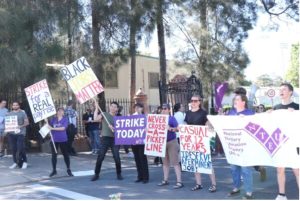
Picture by Christine Lai
Type: News Commentary
Target Media Outlet: Sydney Morning Herald
The University of Sydney has experienced several strikes by academic and professional staff over the years. The most recent strike occurred in late 2021 when the National Tertiary Education Union (NTEU) announced a strike by academic staff to protest the University’s proposed changes to its academic workload model. Academic staff argued that academic workload change would increase their workload and decrease job security. They also protested a lack of staff consultation on the proposed changes.
Here is USYD official statement about industrial action on campus:
The strike received much media attention and generated strong reactions from students and staff. Some students were supportive of the strike, while others were critical, arguing that the strike was disrupting their studies and putting their academic progress at risk. Some staff members who were not members of the NTEU also criticized the strike, arguing that it was not an effective way to resolve the issue and harming the University’s reputation.
In early December 2021, the University and the NTEU reached an agreement, and the strike was called off. The agreement included a commitment to further consultation with staff on workload models and a range of other measures aimed at improving job security and working conditions for academic staff.
However, negotiations between the two parties have been ongoing for almost 24 months, the longest in the history of USYD and for the NTEU at any campus. Moreover, the strikes every semester continue to affect the regular teaching order of the school. There have been two strike days in 2023 S1 alone.
This proposal starts writing news commentary around this controversial and newsworthy dilemma. The two parties have not reached a consensus on this dilemma for a long time, so when will this incident be resolved entirely, and what are the possible solutions? Journalists can also discuss related issues simultaneously, interview NTEU staff or USYD staff, and quote quotes from them for writing support. In addition to the main body of the two parties in this negotiation, the news commentary will mainly focus on discussing this strike dilemma from the perspective of USYD students. Thus, the main interview targets in the news are USYD students to support the argument.
Possible controversial angles include: USYD’s tuition fees increase yearly, and the school’s financial income is abundant. However, students who pay high tuition fees are instead sandwiched between the two parties involved in the incident and are the group most widely affected by a series of strikes. Some of the negative impacts include absenteeism due to strikes, being forced to change study schedules, academic performance affected, etc.

Hi Miranda, I think this topic is worth discussing in a news commentary since we are all students of USYD, and the strikes are continuously impacting both school staff and students. The angle of this commentary is new, and it is necessary to discuss the strike from the student’s perspective. Students may hold different points of view from the school staff, or they support the strike. A suggestion from this point is that you can interview two groups of students who hold different aspects, and conclude the main idea of each group. Social media can be a good choice to help you find your interviewees. In addition, the main reason for the strike was staff dissatisfaction with pay and working hours, you could also include some evidence of this problem, by interviewing a school staff. Overall, I think this blog is on the right track and very good work!